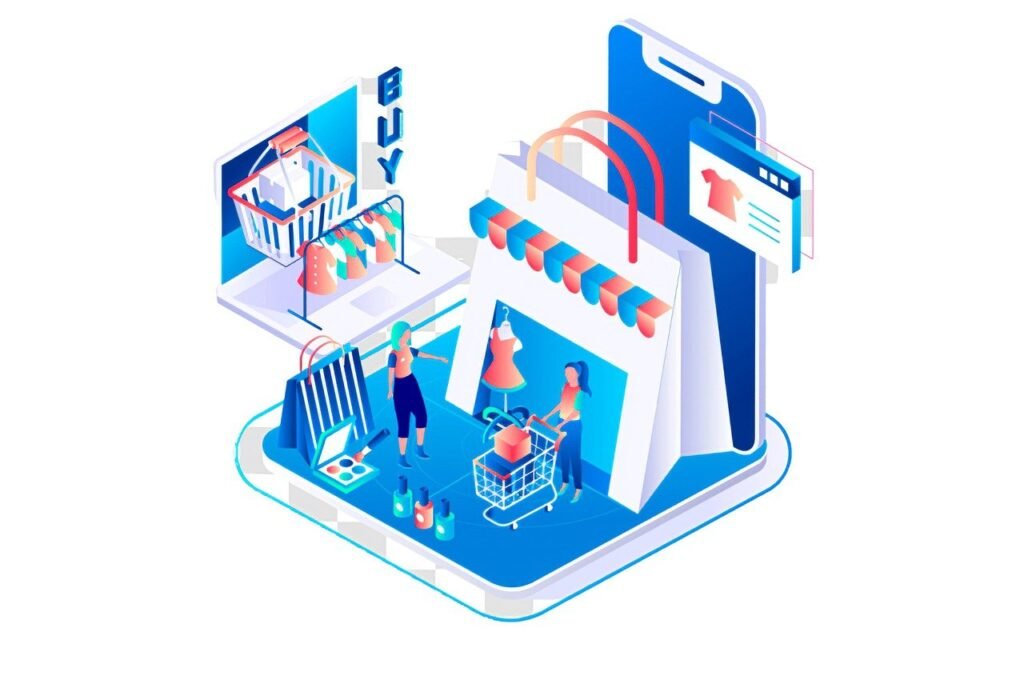This Article has been revised, edited and added to, by Poulomi Chakraborty.
- Setting the Stage: What is Navigational SEO?
- Pillars of Navigational SEO for Green E-commerce
- Challenges in Navigational SEO for Sustainable Retailers
- User Experience (UX) and Navigational SEO: An Inseparable Duo
- Navigational SEO Beyond the Website
- Advanced Techniques in Navigational SEO for Sustainable Retailers
- Monitoring and Adapting: The Evergreen Navigation Strategy
- Conclusion: Navigating the Green Wave Effectively
The green wave has taken over the e-commerce landscape, and sustainable online retailers are at the forefront of this environmentally-conscious revolution. But while having eco-friendly products is a commendable and attractive feature, ensuring that potential customers can effortlessly find what they’re looking for on your website is equally crucial. That’s where navigational SEO comes into play. It’s the compass that guides your visitors, helping them smoothly sail through your site. For sustainable online retailers, optimizing this navigational aspect can amplify both user experience and organic search rankings. Let’s embark on a journey to understand and optimize navigational SEO for the green e-commerce realm.
Setting the Stage: What is Navigational SEO?

At its core, navigational SEO refers to optimization strategies employed to guide visitors to specific areas or products on an e-commerce platform. It’s all about ensuring that the user’s path, from entry to checkout, is as intuitive and seamless as possible.
Why It Matters Especially for Sustainable Retailers
- Educated Audience: Sustainable shoppers are typically well-informed. They seek specifics, be it product origins, materials used, or carbon footprints. An efficient navigational structure ensures they find this information swiftly.
- Diverse Product Range: Many sustainable retailers offer a diverse range of products, from organic clothing to biodegradable kitchenware. Efficient navigation ensures that shoppers find exactly what they’re looking for without sifting through irrelevant items.
The Importance of Streamlined Navigation
For startups, particularly in the e-commerce sector, the ability to guide visitors efficiently from the homepage to checkout can determine the success of the business. Effective navigational SEO isn’t just about aiding users in finding products; it’s about creating a journey that aligns with the users’ needs and your business goals.
Understanding User Intent
At its core, navigational SEO must cater to the specific intents of visitors. This means understanding why users come to your site and what they expect to find. For sustainable online retailers, this often translates into providing a direct path to eco-friendly products while educating the consumer about the sustainability efforts involved in these products. By aligning your navigational structure with user intent, you not only enhance the user experience but also build trust and authority in your niche.
Strategic Layout and Site Architecture
The architecture of your website should facilitate not just ease of finding products but also learning about your brand and its values. This involves organizing content and product listings in a way that reflects common user pathways but also encourages exploration and engagement.
For instance, categorizing products according to their sustainability credentials—like carbon-neutral, recycled materials, or energy-efficient—can help users align their shopping with their values.
Integrating Contextual Information Seamlessly
A key strategy in navigational SEO for sustainable retailers is the seamless integration of contextual information that supports the buying decision. This includes detailed product backstories, the environmental benefits of a purchase, or the social impact of the consumer’s choice.
Such content should be easily accessible at different points in the navigational path to inform and reassure customers that their choices are making a difference.
Adapting to Technological Advances
Navigational SEO is not static; it evolves with technological advances and changing consumer behaviors. Implementing features like predictive search, which anticipates the user’s queries and offers results based on a few keystrokes, can significantly enhance the navigational experience.
Similarly, incorporating voice search optimization, considering the rise in mobile and voice-activated device usage, can provide an edge over competitors.
Pillars of Navigational SEO for Green E-commerce

Navigational SEO isn’t just about having a search bar or a menu. It’s about creating an ecosystem where every element harmoniously aids the user’s journey.
Intuitive Site Structure
Imagine walking into a physical store where products are randomly placed without any order. Overwhelming, right? An online store is no different. The structure of your website should mirror the logic of the shopping process.
- Hierarchical Layout: Start broad, like ‘Men’s Clothing’ or ‘Eco-friendly Home Goods’, then drill down into specifics like ‘Organic Cotton Shirts’ or ‘Bamboo Cutlery’.
- Limit Menu Items: While it’s tempting to list every category, too many options can confuse users. Stick to essential categories, using drop-downs for sub-categories.
Enhanced Internal Search Capabilities
For larger sustainable e-commerce platforms, an internal search function isn’t optional; it’s vital.
- Autocomplete Functions: As users type, offer product suggestions. If someone types ‘solar’, suggestions like ‘solar-powered lamps’ or ‘solar chargers’ can appear.
- Filtering Options: Allow users to filter search results. If someone searches for ‘bedsheets’, offer filters like ‘organic’, ‘fair-trade’, or ‘upcycled’.
BreadCrumbs for Context
Breadcrumb navigation is a secondary navigation scheme that reveals the user’s location on a website.
- Logical Pathways: For instance, Home > Women’s Clothing > Organic Tops > Bamboo Tunic.
- Enhanced SEO: Breadcrumbs can organically include keywords, improving internal linking and boosting SEO.
Mobile-Optimized Navigation
With a significant chunk of online shopping happening on mobile devices, ensuring your navigational elements shine on smaller screens is imperative.
- Responsive Design: Ensure menus, search bars, and other navigational tools adjust and look clean regardless of the device’s screen size.
- Thumb-Friendly Navigation: Given that most mobile users will navigate using their thumbs, place key navigational elements within easy reach, usually at the bottom or center of the screen.
- Quick Load Times: Mobile users expect speed. Ensure that your navigational elements load swiftly, reducing the chance of bounce-backs.
Using Clear, Descriptive Labels
While it might be tempting to get creative with category names, clarity should be the priority, especially in the realm of sustainable products.
- Descriptive Names: Instead of vague category names like ‘Greener Homes’, use ‘Sustainable Home Goods’ or ‘Eco-friendly Kitchenware’.
- Avoid Jargon: While terms like ‘biophilic’ might be trendy in sustainable circles, not every visitor might understand them. Stick to terms that the average shopper can comprehend.
Implementing Visual Navigation
A picture is worth a thousand words. This age-old adage holds when navigating an online store, especially for visual products.
- Category Imagery: Instead of just text, use images to represent categories. For instance, a picture of a bamboo toothbrush for ‘Eco-friendly Dental Care’.
- Highlight Bestsellers: Use visual markers like ‘Top Rated’ or ‘Bestseller’ to guide users towards popular products.
Leveraging User Behavior Data
With tools like Google Analytics, sustainable online retailers can gain a deeper understanding of how users navigate their site.
- Analyze Top Exit Pages: Identify pages where users most frequently drop off. Perhaps a key navigational element is missing or unclear there.
- Track Search Queries: Monitor what users are frequently searching for. If a particular product or category frequently pops up, consider giving it more prominence in your navigation.
Optimizing for Voice Search
As more users adopt voice-activated assistants like Alexa, Siri, and Google Assistant, optimizing your navigation for voice search becomes essential.
- Natural Language Processing: Ensure that product descriptions and navigational elements use natural, conversational language, mirroring how people speak.
- FAQ Sections: Voice searches are often question-based. Having an FAQ section that addresses common questions can improve voice search navigation.
Challenges in Navigational SEO for Sustainable Retailers

While there’s immense potential in optimizing navigation for SEO, sustainable online retailers also face unique challenges.
- Educating While Navigating: Sustainable products often require a bit of education. Balancing this need to inform while ensuring smooth navigation can be tricky.
- Diverse Audience Spectrum: From hardcore eco-warriors to those just starting their sustainable journey, green e-commerce platforms cater to a wide audience spectrum. Crafting a one-size-fits-all navigation can be challenging.
Balancing Educational Content with User Experience
Sustainable products often come with stories and details about their production that are vital for educating consumers and promoting ethical practices. However, integrating this information without overwhelming the visitor is a critical challenge.
The strategic placement of educational content must be planned meticulously to ensure that it enhances rather than hinders the navigational experience. This could involve using modal windows or collapsible sections that provide additional information only when the user opts to engage with them, thus keeping the main navigation clean and focused.
Tailoring Navigation to Diverse Consumer Knowledge Levels
Sustainable retailers cater to a wide range of consumers, from highly knowledgeable environmental advocates to newcomers who are just starting to explore eco-friendly options. Creating a navigational structure that accommodates this spectrum without alienating any group requires a deep understanding of customer personas.
One effective approach is to design adaptive navigation systems that modify content and options based on the user’s previous interactions and chosen preferences. This adaptive approach can guide the user through a personalized shopping experience that educates without overwhelming them.
Overcoming Technical SEO Constraints
While implementing innovative navigational features, sustainable retailers must also ensure that these innovations are built on a solid foundation of technical SEO. Issues such as slow page load times, poor mobile responsiveness, and complex URL structures can derail even the most well-planned navigational strategies.
It’s crucial for startups to invest in robust SEO audits and adopt a mobile-first design philosophy that ensures all navigational elements perform optimally across devices and platforms. Furthermore, clean, semantic URL structures will enhance both user understanding and search engine indexing efficiency.
Ensuring Consistency Across Channels
Sustainable retailers often use multiple channels to reach their audience, including social media, email marketing, and third-party marketplaces. Each of these channels can serve as a starting point for a customer’s journey.
Ensuring that navigational cues are consistent across these channels can be challenging but is essential for providing a cohesive user experience. This might involve standardizing terminologies, aligning visual cues, and synchronizing the timing of promotional campaigns across all platforms.
Incorporating Global Trends and Local Behaviors
As global awareness and regulations around sustainability evolve, online retailers must continuously update their navigational strategies to reflect these changes. This includes understanding local consumer behaviors and preferences in different markets, which may require varying the information and products highlighted.
For instance, a sustainability-focused retailer may need to emphasize different aspects of their products in Europe, where eco-labels and organic certifications are highly valued, compared to the U.S., where there might be a greater emphasis on reducing carbon footprints. Navigational elements must be dynamic and adaptable to reflect these geographical nuances.
Addressing these challenges involves a strategic blend of SEO expertise, user experience design, and a deep understanding of the sustainable consumer’s mindset. By acknowledging and tackling these areas, sustainable retailers can enhance their site’s navigational efficacy, leading to better engagement, higher conversion rates, and a more loyal customer base.

Related: Check out our free SEO suite

User Experience (UX) and Navigational SEO: An Inseparable Duo
Navigational SEO isn’t just about optimizing for search engines; it’s also about optimizing for humans. The intertwining of user experience (UX) and SEO is most evident in website navigation.
The Feedback Loop of Positive UX
- Lower Bounce Rate: When users can quickly find what they’re looking for, they’re less likely to leave the site prematurely. This reduced bounce rate is a positive signal to search engines.
- Increased Time on Site: Intuitive navigation means users spend more time exploring products, reading descriptions, and, ideally, making purchases. Longer session durations can enhance SEO rankings.
Incorporating User Feedback
It’s one thing to assume how users might navigate a site and another to actually know. Sustainable retailers should actively seek feedback.
- Surveys and Feedback Forms: Occasionally, prompt users to provide feedback specifically on site navigation. Was it easy to find products? Were there any roadblocks?
- User Testing: Conduct live user testing sessions to observe how real users navigate the website. This can provide invaluable insights into potential navigational pain points.
Continuous Evolution
The world of e-commerce and sustainability is dynamic. As new products are introduced and consumer behavior shifts, navigational strategies should evolve.
- Periodic Audits: Regularly review the site’s structure, analyzing analytics, and user feedback to ensure navigation remains optimal.
- Adopt New Technologies: From AR-powered product previews to chatbots guiding users, stay open to integrating new tech to enhance navigation.
Designing for Emotional Engagement
Sustainable retailers have a unique opportunity to connect with their customers on an emotional level, given the shared values and commitment to environmental and social responsibility. Emotional engagement can be facilitated through thoughtful UX design that resonates with the user’s values.
For example, incorporating elements like storytelling around product creation, the environmental impact saved, or the communities supported can transform a simple navigation path into a compelling user journey. These stories should be easily accessible through intuitive navigation that reflects a deep understanding of the user’s motivations and desires.
Creating an Inclusive User Interface
Inclusivity in web design ensures that the website is usable and accessible to people with a wide range of abilities and disabilities. This includes implementing accessible menus, readable fonts, adequate color contrasts, and assistive technologies compatibility. For sustainable online retailers, this is particularly pertinent as it aligns with the broader values of inclusivity and responsibility towards the community and the environment.
Ensuring that your website adheres to WCAG (Web Content Accessibility Guidelines) not only enhances UX but can also improve SEO by making the site accessible to a wider audience and increasing the time they spend on the site.
Leveraging Microinteractions for Enhanced Navigation
Microinteractions are subtle effects and animations that occur when a user interacts with a webpage. They can significantly enhance navigational SEO by guiding the user’s attention and providing instant feedback on their actions.
For example, when a user selects a product category related to sustainability, subtle animations or changes in color can highlight the path, providing a visual cue of their navigation choice. This not only makes the interaction more engaging but also helps reinforce the user’s decision-making process, increasing the likelihood of a purchase.
Prioritizing Speed and Simplicity
The speed at which pages load and the simplicity of the navigation are critical factors in user satisfaction and SEO. Users expect quick access to information, particularly when shopping for products online. Sustainable retailers should focus on optimizing site speed by compressing images, leveraging browser caching, and minimizing the use of heavy scripts.
Similarly, a simple, clean navigation bar with a minimal number of categories can help users find what they need quickly without overwhelming them with choices. This approach can reduce bounce rates and improve the overall effectiveness of the site’s SEO strategy.
Integrating Real-Time User Feedback
Incorporating real-time feedback mechanisms into the website can significantly enhance UX and navigational SEO. Tools like live chat support or feedback pop-ups allow users to report issues or confusion in real-time, enabling immediate resolution and improving their overall experience.
This direct line of communication not only helps in optimizing the navigation based on actual user experiences but also builds trust and reliability, crucial for sustainable brands where consumer loyalty often depends on trust in the brand’s values and practices.
Navigational SEO Beyond the Website

While on-site navigation is paramount, sustainable online retailers should also consider off-site elements that guide users to their website.
Social Media as a Navigational Tool
Platforms like Instagram, Facebook, and Pinterest can act as navigational starting points, guiding users to specific products or sections.
- Link in Bio: Use tools that allow multiple links from a single bio link, guiding users to various sections of the site.
- Story Highlights: For platforms like Instagram, curated story highlights can act as a visual navigation menu, directing users to bestsellers, new arrivals, or specific product categories.
Email Newsletters
For subscribers and past customers, email newsletters can act as a direct navigational route.
- Segmented Campaigns: Send tailored emails to different user segments, guiding them to products or sections most relevant to them.
- Highlight Navigational Changes: If there’s a new product category or a significant change in site structure, inform your email subscribers, guiding them to explore.
Integrating with Social Commerce
The rise of social commerce offers a vital opportunity for sustainable retailers to extend their navigational strategies into social media platforms where their target audience already engages. By integrating direct shopping capabilities into social media posts and stories, retailers can reduce the steps users must take from discovery to purchase.
For instance, Instagram’s shopping feature allows users to tap on a product featured in a post and be taken directly to the product purchase page within the same app. This seamless integration keeps the user’s journey smooth and quick, reducing the risk of drop-offs and increasing conversion rates.
Leveraging Geo-Targeting on Digital Ad Platforms
Geo-targeting in digital advertising allows sustainable retailers to present tailored navigational cues to users based on their location. This strategy is particularly effective in promoting localized products or services, such as local delivery options for sustainable goods, special promotions in specific areas, or events like pop-up shops.
Using geo-targeted ads, retailers can guide users from a specific region directly to customized landing pages that cater to their local needs and preferences, enhancing the relevance of the navigation and the likelihood of a conversion.
Optimizing for Progressive Web Apps (PWAs)
Progressive Web Apps (PWAs) offer a mobile-app-like experience on web browsers, providing capabilities that are particularly advantageous for navigational SEO. PWAs load quickly, work offline, and can send push notifications to users, making them an excellent platform for enhancing user engagement.
For sustainable retailers, PWAs can be used to push updates on new eco-friendly products, special campaigns, or even educational content directly to a user’s device, effectively guiding their navigation even when they are not actively browsing the website.
Enhancing Navigation with Augmented Reality (AR)
Augmented Reality (AR) can transform the way users interact with sustainable products online. By integrating AR features, retailers can allow users to see how a product might look in their environment or how it functions before buying.
For example, an AR feature could enable users to visualize how a piece of furniture made from recycled materials would look in their living room. This technology not only enriches the user experience but also serves as a powerful navigational tool, guiding users toward making informed and satisfied purchase decisions.
Exploiting Smart Speaker Integrations
With the increasing prevalence of smart speakers in households, optimizing navigational SEO for voice search through these devices can provide a significant competitive edge. Sustainable retailers can develop skills or actions for platforms like Alexa or Google Assistant that facilitate shopping via voice commands.
These voice applications can guide users through the product catalog, provide additional product information, and even handle transactions, all through spoken interaction. This approach not only simplifies the navigation for users but also aligns with the hands-free, sustainable lifestyles that many eco-conscious consumers appreciate.
Advanced Techniques in Navigational SEO for Sustainable Retailers
In a world brimming with technological advancements, navigating the e-commerce realm (especially the green niche) requires staying ahead of the curve. Let’s delve into some advanced techniques that can elevate navigational SEO for sustainable online retailers.
Personalized User Navigation
In today’s digital age, one-size-fits-all doesn’t cut it. Personalizing the navigation experience can make users feel understood and valued.
- Behavior-Based Recommendations: Use algorithms to suggest products based on past browsing behavior, searches, and purchases.
- User Profiles and Wish Lists: Allow users to create profiles where they can bookmark favorite products, making repeat visits and navigation more streamlined.
AI-Powered Search Enhancements
Artificial Intelligence can significantly enhance the internal search experience on e-commerce platforms.
- Natural Language Processing (NLP): NLP can understand and process user’s search queries in a more human-like manner, catering to colloquial terms or phrasings.
- Image Search: Allow users to search using images. If someone saw an eco-friendly product somewhere but doesn’t know its name, they can upload a picture to find similar items on your platform.
Interactive Site Maps
Go beyond the traditional site map. An interactive site map can act as a visual guide, aiding users in their navigation journey.
- Visual Categories: Use icons or images to represent different product categories.
- Hover Details: As users hover over sections of the interactive map, offer brief descriptions or product previews.
AR (Augmented Reality) Navigation Enhancements
Augmented Reality can offer a more immersive navigational experience, especially for products where visualization is crucial.
- Virtual Try-Ons: For sustainable fashion retailers, allow users to virtually try on clothing or accessories.
- 3D Product Previews: Offer 3D views of products, which users can rotate and zoom, providing a comprehensive understanding of the item.
Incorporating Voice Assistants for On-Site Navigation
As homes become smarter with devices like Google Home or Amazon Echo, integrating on-site voice assistants can enhance navigation.
- Voice-Prompted Searches: Users can vocally describe what they’re looking for, with the voice assistant guiding them to relevant products.
- Voice FAQ Assistants: These can quickly answer common questions, reducing navigation barriers for potential buyers.
Monitoring and Adapting: The Evergreen Navigation Strategy

The realm of green e-commerce, much like the broader digital landscape, is ever-evolving. A robust navigational strategy acknowledges this dynamism, continuously monitoring user behavior, and adapting accordingly.
Heatmaps and User Flow Analysis
- Understand User Behavior: Tools like Crazy Egg or Hotjar can offer insights into where users click, how far they scroll, and more.
- Identify Pain Points: If a particular section consistently sees drop-offs, there might be a navigational barrier worth addressing.
A/B Testing for Navigational Elements
- Test Variations: Experiment with different menu structures, search bar placements, or filter options to see which resonates best with users.
- Data-Driven Decisions: Base navigational tweaks or overhauls on concrete data, ensuring changes enhance user experience and SEO.
Utilizing Advanced Analytics for Deeper Insights
In the digital age, leveraging the power of advanced analytics is crucial for understanding how users interact with your website. By going beyond basic metrics like page views or bounce rates, sustainable retailers can employ more sophisticated analysis techniques such as session replay and heat mapping.
These tools provide a visual representation of where users click, how far they scroll, and which elements of your site attract the most attention. This data can be invaluable for identifying which parts of your navigational structure work well and which need refinement to better serve the users’ needs.
Implementing Dynamic Navigation Systems
To accommodate the diverse and evolving needs of users, dynamic navigation systems can be implemented that adjust based on user behavior and external factors such as market trends or seasonal changes.
For instance, if analytics indicate a surge in interest in a specific category of products, the navigation can automatically adjust to make these products more prominent. This flexibility can significantly enhance the user experience by making relevant products easier to find at just the right time.
Continuous User Experience Testing
Ongoing testing is vital to refining the navigation and overall user experience of an e-commerce platform. Sustainable online retailers should establish a routine of regular user experience testing, including A/B testing different navigational structures, to empirically determine what works best for their audience.
This can involve testing variations in menu layouts, information architecture, and even the terminology used in navigation links to ensure clarity and effectiveness in guiding users through the buying process.
Engaging with Community Feedback
For sustainable businesses, community engagement is often a cornerstone of their brand. Actively seeking out and incorporating feedback from your user community can provide direct insights into how your navigation meets their needs and expectations.
This can be done through social media interactions, dedicated feedback forms, or community forums. Regularly engaging with your audience in this way not only helps refine your navigational approach but also strengthens the relationship between your brand and its customers.
Leveraging Predictive Analytics for Proactive Adaptation
Predictive analytics can transform a retailer’s approach to navigational SEO by forecasting future user behaviors and market conditions. This proactive strategy allows retailers to adapt their navigational elements before changes in user behavior become a trend.
For example, if predictive tools suggest an increasing interest in zero-waste products, the retailer can modify the navigation to highlight these products before the trend fully takes hold, positioning the retailer as a forward-thinking leader in the space.
Conclusion: Navigating the Green Wave Effectively
Navigational SEO is more than a technical strategy; it is a bridge that connects sustainable online retailers with the eco-conscious consumer. By implementing effective navigational SEO, retailers can ensure that their websites not only attract visitors but also engage and convert them effectively. This requires a deep understanding of both the technology and the unique values and preferences of the target audience.
The journey involves continuously refining and adapting the navigational elements based on user feedback, market trends, and technological advancements to ensure a seamless shopping experience. As sustainability becomes more central to consumer choices, the ability to guide and educate users through a well-structured, intuitive online platform can significantly differentiate a brand.
This strategic alignment of navigational SEO with user experience ensures that sustainable products are not just visible but also valued and chosen by consumers, fostering a stronger connection between ethical brands and their communities. Thus, mastering navigational SEO is essential for any sustainable retailer looking to thrive in the competitive e-commerce landscape.
Read Next:




















